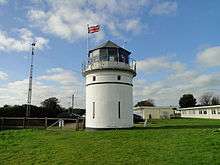Pakefield Lighthouse
 Pakefield in 2014 | |
 Suffolk | |
| Location |
Pakefield Suffolk England United Kingdom |
|---|---|
| Coordinates | 52°26′13″N 1°43′45″E / 52.4370°N 1.7293°ECoordinates: 52°26′13″N 1°43′45″E / 52.4370°N 1.7293°E |
| Year first constructed | 1832 |
| Deactivated | 1864 |
| Construction | brick tower |
| Tower shape | massive cylindrical tower with balcony, lantern and conical roof |
| Markings / pattern | white tower, black lantern and roof |
| Height | 9 metres (30 ft) |
| Focal height | 20 metres (66 ft) |
| Range | 9 nautical miles (17 km; 10 mi) |
| ARLHS number | ENG-098 |
| Managing agent | Pakefield Coastwatch[1] |

Pakefield Lighthouse is a decommissioned 19th century lighthouse which was built near Pakefield a suburb of Lowestoft in Suffolk. The lighthouse tower has been used for a variety of maritime, civilian and military roles, and is currently used as a Coastwatch lookout post.[2]
History
Completed in 1832 to a design by the architect Richard Suter, it was commissioned by Trinity House to enable a safe passage to be made through the channel between two shifting sandbanks into Lowestoft on this part of the North Sea coastline.[3]
The 9 metres (30 ft) high white tower and keeper’s accommodation were built within the estate of Pakefield Hall, on low cliffs overlooking the sea at a cost of £821 (equivalent to £68,791 in 2015).[4]
The light was powered by two argand lamps, originally consisted of a constant white light that could be seen for nine nautical miles. The colour was changed to red as some ships had confused the light with those shining from the windows of clifftop houses in nearby Kessingland.[5]
By the time that land negotiations regarding the lighthouse and access road had been completed in 1850, the need for the light had already passed, as the channel had moved to the south requiring a new light near Kessingland. The lighthouse continued in use, until it was finally decommissioned in 1864.[6]
The lighthouse remained abandoned for a number of decades until it was subsequently sold to the owners of the Hall in the 1920s, the grounds of which being used as a campsite, and would eventually become a Pontins holiday camp.[6]
In 1938, prior to the Second World War, the tower became an observation post for the Royal Observer Corps, who were checking for any possible seaborne or air invasion force, with both the roof and lantern being removed to improve visibility.[6]
The tower continued to be used throughout the war, with Auxiliary Territorial Service personnel being stationed at the site. The surrounding holiday campsite was requisitioned and became a transit camp. It was strafed by the Luftwaffe during an air-raid on Lowestoft in 1943, and in the following year a V-1 doodlebug with a defective gyrocompass was spotted travelling towards the lighthouse, until it crashed into the sea at the base of the cliffs nearby.
After the war, the tower was eventually purchased by Pontins, and in the 1960s it was used by the camp’s official photographers as a dark room. The lighthouse tower was renovated in 2000, by voluntary workers from the local Pakefield Coastwatch group, and it is now used by the group as a coastal reconnaissance station.[2][7]
See also
References
- ↑ Pakefield The Lighthouse Directory. University of North Carolina at Chapel Hill. Retrieved 5 June 2016
- 1 2 Rowlett, Russ. "Lighthouses of Eastern England". The Lighthouse Directory. University of North Carolina at Chapel Hill. Retrieved 2 August 2015.
- ↑ "Pakefield Lighthouse". worldwidelighthouses.com. Retrieved 2 August 2015.
- ↑ UK CPI inflation numbers based on data available from Gregory Clark (2016), "The Annual RPI and Average Earnings for Britain, 1209 to Present (New Series)" MeasuringWorth.
- ↑ John William Norie (1846). New and extensive sailing directions for the navigation of the North sea, arranged and written to accompany the new charts, drawn by J.W. Norie. pp. 19–.
- 1 2 3 "Pakefield Lighthouse". mycetes.co.uk. Retrieved 2 August 2015.
- ↑ "Pakefield Coastwatch". pakefieldcoastwatch.co.uk. Retrieved 2 August 2015.